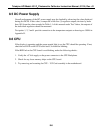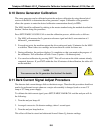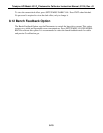
Teledyne API Model 401 O
3
Photometric Calibrator Instruction Manual, 01124, Rev. J2
9 TROUBLESHOOTING
NOTE
The operations outlined in this chapter are to be
performed by qualified maintenance personnel only.
9.1 Overview
The Model 401 Photometric Calibrator has been designed to rapidly detect possible problems
and allow their quick evaluation and repair. During operation, the calibrator continuously
performs self-check diagnostics and provides the ability to monitor the key operating parameters
of the instrument without disturbing monitoring operations. These capabilities will usually allow
the quick isolation and resolution of a problem.
A systematic approach to troubleshooting will generally consist of the following four steps,
performed in order:
1. Confirm the proper operation of fundamental instrument sub-systems (Power Supplies, CPU,
Display).
2. Note any warning messages and take corrective action as required.
3. Examine the values of all TEST functions and compare to factory values. Note any major
deviations from the factory values and take corrective action as required.
4. Address any dynamic (Sample related) problems.
The following sections provide a guide for performing each of these steps. Figure 1-7 in this
manual shows the general layout of components and sub-assemblies in the analyzer and can be
referenced in performing the checks described in the following sections.
9.2 Troubleshooting Fundamental Calibrator Operation
When the Calibrator is turned on, several actions will normally occur which indicate the proper
functioning of basic instrument sub-systems. These actions are:
1. The green sample light on the front panel should turn on.
2. The Display should energize and display a log-on message followed by a standard "STBY"
display (See Figure 2-2 for illustration of a normal display.
3. The pumps should start momentarily.
9-1


















